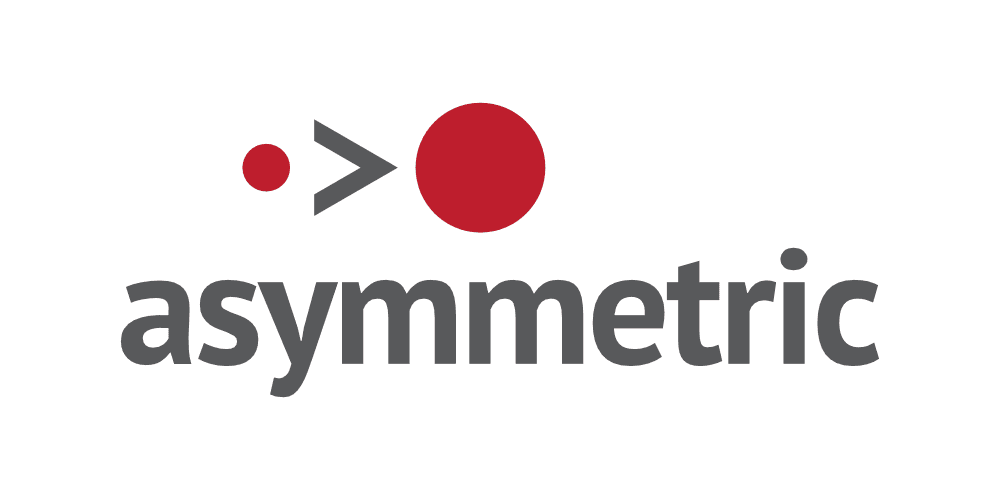To compete against larger competitors with more resources, you must find strategies, tools, tactics, and processes that level the playing field.
One of the least understood business concepts is product pricing.
As the founder and Chief Executive Officer of several companies, I have noted over the years the lack of understanding of pricing principles by companies of all sizes. Let's examine them here.
Pricing Principles and Strategies
When considering pricing, there are three primary inputs:
- The customer’s ability and willingness to pay the price
- Price levels of competing products
- The company’s cost structure, including all business costs
Understanding the perceived value of a product is crucial as it influences the price consumers are willing to pay.
There are three fundamental pricing principles:
Cost-Plus Pricing
Cost-plus pricing is the simplest and most common pricing strategy. It entails taking the product cost (including material, labor, shipping, marketing, and overhead) and adding a percentage.
This method ensures that you cover your costs and make a profit from your products, but it fails to consider the customer’s point of view and the role competing products play in the marketplace.
For example, you are launching a line of custom widgets. You want to use cost-plus pricing to determine the best price to ensure the profitability of your new product.
The cost for your new widgets is:
- Material costs: $6.00
- Labor costs: $10.00
- Shipping costs: $5.00
- Marketing and overhead costs: $9.00
You decide to use a 50% markup, so your price is:
Cost ($30) x Markup (1.50) = Selling Price ($45.00)
Cost-plus pricing is easy to use and calculate and provides consistent returns. However, this principle does not consider the customer’s ability and willingness to pay or the price levels of competing products.
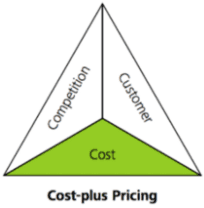
Competitive Pricing Analysis
Competitive pricing strategy uses competitors’ pricing as a benchmark and then prices your product at or below that benchmark. Competitive intelligence can give additional insight into how to best employ this methodology. This principle implies that the competition has determined a reasonable price, and the marketplace accepts the prices.
This principle works best in industries with commoditized or highly similar products where the price is the primary driver for winning the sale. You rely on your price as the primary differentiator between your product and your competition.
Understanding your product or service’s price elasticity is also important to determining the likely effect of price changes.
Competitive pricing can be effective if you have lower-cost inputs or can negotiate better pricing from your suppliers. A cost-efficient business model may also help you employ a competitive pricing strategy.
This principle considers the price level of competing products and the company’s costs but fails to adequately consider the customer’s ability and willingness to pay the price.
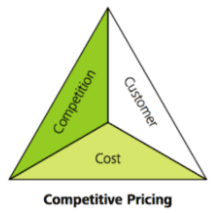
Value-Based Pricing
Value pricing sets the price based on what the customer thinks the product is worth. Value pricing is a pricing strategy based on what the customer thinks the product is worth. Companies that sell unique products are better positioned to take advantage of value pricing. For this to work, the company must understand how customers value the product. The buyer’s point of view is the driving factor in successfully implementing value pricing.
Value pricing is the superior method for pricing products that can be differentiated on quality, features, benefits, or desirability.
This principle considers all three inputs: the customer’s ability and willingness to pay, the price levels of competing products, and the company’s cost structure. Your target audience may pay more for your product, but the value is not what your target audience will pay for. Value is created by the customer’s perception of how benefits apply to them. You must clearly understand how products create value for your customers. It is possible to see it practically: instead of pricing the product, price the customer.
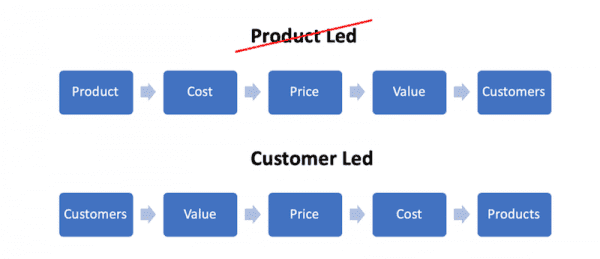
Value pricing usually allows you to recognize higher prices and more profit from your products. It encourages good brand marketing, effective communication, and ongoing product innovation.
Tools that are necessary to win using value pricing include:
- A well-developed and properly positioned brand
- Great products that have unique benefits and features
- Marketing campaigns that resonate with the target audience
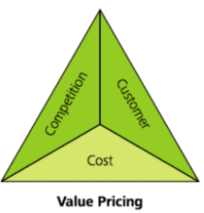
A simple formula for determining value pricing is to determine, from the customer’s perspective, what benefit he gains from the product minus the cost to get those benefits.
Value (V) = Benefits (B) - Cost (C)
However, this formula is too simplistic to employ in a competitive market. What we need to do is to combine value pricing with competitive pricing. We will not end up with absolute value but rather relative to his other choices. We’ll call this Differential Value.
Differential value can be illustrated as follows:
Differential Value (dV) = Differential Benefits (dB) - Differential Cost (dC)
Differential benefits include both tangible and intangible benefits. For example, “easy to use” is an intangible benefit, whereas “maintenance-free” is a tangible benefit. Both are to be considered when determining differential value. Another important consideration is opportunity costs that may be avoided or saved.
Needless to say, for a customer to be willing to purchase a product using value pricing, the differential value must be positive. Otherwise, the benefits are worth less than the cost, and the customer won’t make the purchase. Thus:
Another name for this idea is Economic Value to Customer (EVC). The Economic Value to the Customer (EVC) of an offer is the maximum achievable price for the customer to find the offer attractive.
Economic Value to Customer = Price a < = Price b + Differential Benefit
So, looking at the equation above, the highest price you can expect to achieve is the price of your nearest competitor plus the value advantage your product has over that competitor.
For example, if my nearest competitor’s price is $500, my price to achieve EVC is $500 plus the value of any additional benefits my product offers. Remember that these additional benefits can be tangible or intangible, and my ability to communicate this value may significantly increase it.
Price Structure
The price structure is a pricing model designed to capture the most affordable price for each customer group. Optimizing pricing in certain industries, such as airline companies that sell identical airplane seats with different conditions depending on the customer’s profile, is possible. However, creating a segmented pricing structure that differs not only in the price but also in the offer and qualifying criteria is difficult.
Bundles can be a powerful tool if you combine elements that would be more price-sensitive if sold individually. Bundling a low-priced service with other products can sometimes work better than simply lowering its price. Examples include low-cost financing, payment terms, and anything else that customers may not value as much. Bundling optional services for free is a bad idea unless the cost to deliver the service is very low.
Conjoint Analysis
One of the best tools for determining EVC in a statistically viable manner is conjoint analysis. Conjoint analysis is a popular method of product and pricing research that explores customers' preferences.
It uses the information gathered in the research process to help determine product features, price sensitivity, and potential market share and predict the market's acceptance of a product.

Who Should Manage Pricing?
General management is ultimately responsible for the enterprise's profitability. Still, the General Manager is usually not the person most in touch with the details of a proper pricing decision.
Value-Based Pricing is the most profit-maximizing strategy of all pricing strategies. To use Value-Based Pricing, the person pricing a product or service must understand the value the customer or customer segment derives from the product or service.
Also, the person must be able to understand and compare the market landscape, including the prices of competitors and their differentiating factors.
To ensure profitability, one must know how much money was spent on the product's construction.
Only one person understands these values and can put a dollar value on each of them. That is the Product Manager. Because of this level of insight, they should be responsible for pricing.
Aspiring PMs: Next time you use/purchase/see a product, question its value. Put a dollar value on it and verify that the return on your investment (ROI), meets your expectations. You can do the same thing with a competitor's product. Do some mental math to determine how much it would have cost to produce the product. Find out which product is right-priced and why.
The Bottom Line
The price you put on your products is a major determinant of your company’s profitability and competitiveness. In some cases, lower prices can attract different customer segments and increase market share. The perceived value of your product plays a critical role in determining the optimal price point.
To do pricing well, you must seek a pricing principle appropriate for your product and market. Then, you must research your potential customers and your competition to determine how you can recognize the optimal amount of revenue from each unit sold.
Pricing is one of the most important attributes of your product. It communicates many things about your product, your brand, your company, and the value you purport to offer.
It is far too important to just wing it.

Frequently Asked Questions (FAQ) About Pricing
What are the key principles of effective pricing?
Key principles include understanding customer value, competitive analysis, cost-plus, dynamic, and psychological pricing. Each principle helps in setting prices that maximize profitability while meeting customer expectations.
How does customer value impact pricing?
Customer value is understanding what customers are willing to pay based on their perceived benefits. Pricing should reflect your product or service’s value to ensure customer satisfaction and loyalty.
What is competitive analysis in pricing?
Competitive analysis involves evaluating competitors’ pricing strategies to understand the market landscape. This helps you set competitive prices while differentiating your offerings. Competitive analysis can also help you decide if a lower price is necessary to attract customers.
What is cost-plus pricing?
Cost-plus pricing involves calculating the cost of producing a product or service and adding a markup to ensure profitability. This method ensures all costs are covered and maintains a profit margin.
What is dynamic pricing?
Dynamic pricing is a strategy in which prices are adjusted in real time based on market demand, competition, and other external factors. This allows businesses to maximize revenue and stay competitive.
How does psychological pricing work?
Psychological pricing involves setting prices that impact consumers, such as pricing a product at $9.99 instead of $10.00. This can create a perception of value and influence purchasing decisions.
What is product pricing?
Product pricing involves evaluating and optimizing the prices of your products to maximize profitability and meet customer expectations. It includes a well-thought-out pricing analysis and considers the impact of price adjustments on overall business profits.
How can I determine the right pricing strategy for my business?
The right pricing strategy depends on your business goals, target market, cost structure, and competitive landscape. Conducting market research and experimenting with different pricing models can help identify the most effective strategy.
What role does pricing play in my overall business strategy?
Pricing is critical to your business strategy as it directly impacts revenue, profitability, and market positioning. Effective pricing can enhance your brand image, attract customers, and drive business growth.
How often should I review and adjust my pricing?
Pricing should be reviewed regularly, at least annually, or when significant changes occur in the market, costs, or competitive landscape. Regular reviews ensure your pricing remains competitive and aligned with your business objectives.
What are common mistakes to avoid in pricing?
Common mistakes include underpricing, overpricing, neglecting market research, ignoring customer value, and failing to adjust prices based on market changes. Avoiding these mistakes can help ensure your pricing strategy is effective and sustainable.

Implement Pricing Principles in Your Business Today
Understanding and applying the right pricing principles can significantly enhance your business profitability and customer satisfaction.
Get Expert Guidance
📧 Email: mark.hope@asymmetric.pro
📞 Phone: (608) 410-4450
Schedule a Consultation
Click here to book a convenient time for us to discuss how we can help you develop an effective pricing strategy tailored to your business needs.
About the author
Mark A. Hope is the co-founder and Partner at Asymmetric Marketing, an innovative agency dedicated to creating high-performance sales and marketing systems, campaigns, processes, and strategies tailored for small businesses. With extensive experience spanning various industries, Asymmetric Marketing excels in delivering customized solutions that drive growth and success. If you’re looking to implement the strategies discussed in this article or need expert guidance on enhancing your marketing efforts, Mark is here to help. Contact him at 608-410-4450 or via email at mark.hope@asymmetric.pro.

